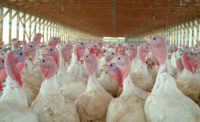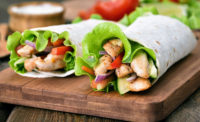In the broiler sector, all eyes are on the possible return of avian influenza this fall and winter, as Canadian waterfowl begin to migrate south along the Atlantic flyway, which touches major broiler production areas in Delmarva, North Carolina, Georgia and Alabama. And will it re-appear in the Mississippi flyway and its major production centers in Arkansas and eastern Oklahoma and Texas?
Rigorous implementation of biosecurity principles will be essential to preventing disease introduction onto broiler operations. NCC has tripled our outreach on the importance of implementing and maintaining sound biosecurity on every broiler farm. Each industry in the poultry sector has been preparing similarly. By maintaining this strong collaboration and sharing of lessons learned, I am confident we will all be in a much better place this year.
Nothing is assured, of course, but feed costs should remain manageable. Other costs, especially energy, are forecast to be lower, consumer demand is on track to stay strong and exports will hopefully rebound from the decreased levels experienced this year. Next year should be another profitable year for chicken producers.
Winner, winner! Beyond just dinner …
Chicken consumption remained high in 2015 in the two primary purchase channels — supermarket and foodservice establishments — according to a survey commissioned by NCC. (The survey was conducted online by ORC International June 22-24, 2015, among 1,019 adults. Funding was provided by WATT Poultry USA and Elanco.)
Eighty-five percent of consumers ate a chicken meal or snack purchased from a supermarket and 67 percent ate a chicken meal or snack from a food service establishment in the two weeks leading up to the survey. These numbers are at parity with those seen in 2014.
In the next 12 months, 23 percent of consumers anticipated eating more chicken from the supermarket and 14 percent anticipated eating more from a food service establishment.
Consumers with the highest consumption levels tend to skew younger and more ethnically diverse, with larger households. Noteworthy also is that consumer purchase is highest in the Northeast, Midwest and South.
As part of the survey, consumers were asked to consider their most recent chicken purchase and rank various factors in order of importance. Basic, functional benefits including freshness, price and taste were ranked highest as influencers in consumers’ purchase decision-making.
While three in 10 (29 percent) consumers have no concerns about buying chicken, other consumers are most likely to be concerned about product freshness and health/safety. Concerns regarding product freshness and health/safety are top of mind for approximately one in four consumers.
Eight in 10 (80 percent) consumers report they would seek information to assuage their chicken concerns. Consumers are most likely to use the USDA website or a brand/company website to find more information about the chicken they buy.
Even though federal law prohibits their use, 55 percent were extremely or very concerned about hormone and steroid use in chicken production.
According to USDA, per capita chicken consumption is expected to increase about five pounds in 2015. Such an increase has not been experienced in the chicken industry’s history.
2015-16 broiler production
USDA estimates broiler production to be up more than 4 percent in 2015 and another 3 percent in 2016, although some analysts say these estimates are bit high for both years. It is likely that production this year may reach 4 percent, but will not exceed that level. For 2016, production will likely increase about 2 or 2.5 percent.
The pendulum that swung too low on the number of hens in the hatchery supply flock in 2014 is swinging too high for 2016. Almost 7 percent more hens are scheduled to be in-lay during the first half of 2016. But this does not correlate to 7 percent more eggs set in 2016 because there is not the hatchery capacity to do so, nor is there currently the growout housing or processing capacity to achieve such an increase.
One of the most pronounced trends in recent years has been the continual shift toward more large birds for deboning. This trend is especially evident in 2015 with more than 20 percent of broilers in the heaviest of USDA’s four weight categories. These birds account for almost 30 percent of total pounds produced. The trend will continue in 2016 but at more modest pace when compared with the shift this year.
In 2016, the broiler sector also will see some new capacity coming online, as plants are either expanding or being built in Arkansas, North Carolina and Texas.
Export markets
Avian influenza’s impact on the broiler sector has been negligible through the spring and summer in regard to production capabilities, but our export market has taken a hit by various trade restrictions put in place in response to the virus, from China, South Korea and others. Our exports have also been under additional pressure from Russia, which completely shut out U.S. poultry meat since last August because of geopolitical reasons stemming from the situation with Ukraine last year.
While international market closures due to non-tariff trade barriers and avian influenza have tempered the export market this year, industry efforts to address these barriers, improved biosecurity and U.S. government efforts to regionalize the impact of avian influenza on trade gives me optimism for 2016.
I am also hopeful about our chicken entering a few new markets next year, as well. As has been announced to the public by its trade minister, South Africa has agreed to an annual antidumping duty-free quota of 65,000 metric tons, which also allows for future growth. After rigorous work and negotiations between the U.S. industry, U.S. trade representatives and our counterparts in South Africa, we are on the brink of re-entering that market, where we have been unjustly shut out for the past 15 years.
The World Trade Organization’s ruling earlier this year rejecting India’s appeal of its ban on U.S. poultry imports was a resounding win for our industry. India placed a ban on U.S. poultry in 2007 under the excuse of preventing low pathogenic avian influenza, but produced no scientific evidence to support the ban’s validity. It was thinly guised protectionism. I am hopeful that that the Indian administration will comply with the ruling and will be amenable to working with the U.S. government and industry to remove all restrictions and allow access for U.S. poultry in the near future. We estimate the removal of India’s restrictions would generate $300 million a year.
Embracing transparency
We understand people are more curious than ever about how their food gets from the farm to their table and how that process has changed over time. As chicken producers, we know the health and welfare of the birds falls squarely on us, and we take that responsibility very seriously.
The 2015 Chicken Media Summit, sponsored by the National Chicken Council and the U.S. Poultry & Egg Association, was held earlier this year on Maryland’s Eastern Shore. The summit brought together about 30 members from national and local media, bloggers and dieticians, including The National Provisioner. The attendees saw firsthand the entire process, from egg to fork, about how chickens are hatched, raised and processed for food. The group toured a Perdue Farms hatchery, a family farm that raises chickens for Mountaire, an Amick Farms processing plant and the Perdue Innovation Center.
A panel discussion on “Chicken Myths and Facts” addressed issues related to bird size, antibiotics, hormones, litter and general industry issues. A second panel discussion on “Food Safety: Focus on Salmonella” included an overview of food safety practices, a history of FSIS inspections, information on the new FSIS Poultry Inspection System and efforts to reduce Salmonella prevalence on chicken parts.
Expect more from NCC in 2016 as we continue to show consumers, customers and the media what it is we do, why we do it and how proud we are to produce America’s favorite protein. NP
State of the Industry 2015 segments
| Industry overview | Goes live Oct. 6 |
| Food Safety | Oct. 7 |
| Packaging | Oct. 8 |
| Beef (NCBA) | Oct. 9 |
| Beef (CAB) | Oct. 12 |
| Pork | Oct. 13 |
| Chicken | Oct. 14 |
| Turkey | Oct. 15 |
| Veal | Oct. 16 |
| Lamb | Oct. 19 |








